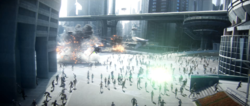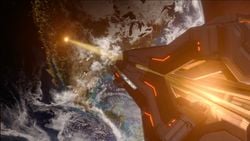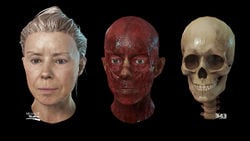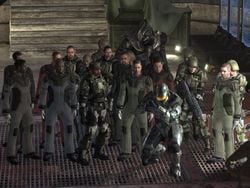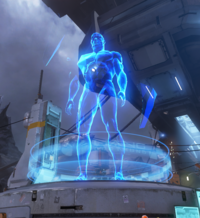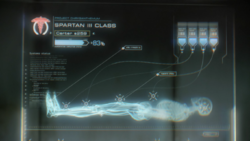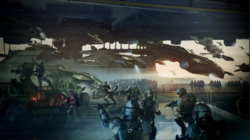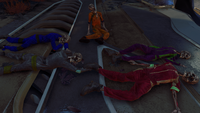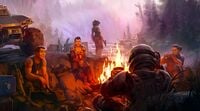Human
From Halopedia, the Halo wiki
| There is more information available on this subject at Human on the English Wikipedia. |
| Human | |
|---|---|

| |
| Biological overview | |
|
Latin name: |
Homo sapiens[1] |
|
Classification: |
Mammal |
|
Diet: |
Omnivorous |
| Physical information | |
|
Avg. height: |
152.4–182.9 cm (5–6 ft)[1] |
|
Avg. weight: |
61.2–90.7 kg (135–200 lb)[1] |
|
Avg. lifespan: |
80–90 years[1] |
| Sociocultural information | |
|
Homeworld: |
|
|
Notable individuals: |
John-117, Catherine Halsey, Preston Cole, Terrence Hood, Forthencho, Robert Watts |
|
Also known as: |
|
|
Languages: |
|

This article is part of a series on
Humanity
- Technology
- History
- Culture, Politics & Economy
- Biology
To check out information for other sapient species, see here!
Humans, taxonomically referred to as Homo sapiens (Latin for "wise man") and known as hamanune (plural hamanush) in the Forerunner era,[3] are a sentient species native to Earth. A part of the primate family, they are the only extant species of a formerly diverse genus of multiple species once classified as human. Members of the species, like some Covenant species, are four-limbed and bipedal, which enables them to walk upright on two legs and use their arms and hands (including opposable thumbs) to hold and manipulate objects such as tools.
Over 110,000 years ago, ancient humanity (archeohomina) had achieved a thriving interstellar civilization nearly on par with the Forerunners, although their catastrophic defeat in the human-Forerunner wars would see them reduced to a preindustrial state as hunter-gatherer tribes, forced to achieve technological sophistication again.[4] Thanks to the efforts of the Forerunner known as the Librarian, however, humans were later elevated to the role of Reclaimers, intended to inherit the Mantle the Forerunners used to hold. Humanity would not begin to rise from the confines of their homeworld until nearly 100,000 years later, with the re-invention of space travel in the mid-20th century and the beginning of space colonization in the latter half of the 21st century. Following a series of violent conflicts across the Sol system, contemporary humanity at large was brought under a single banner with the establishment of the Unified Earth Government in 2170. Over a century later, the invention of the Shaw-Fujikawa Translight Engine heralded a new golden age for humanity: no longer confined to their home system, humans spread across the neighbouring stars.[5]
At the end of the 25th century, this age of flourish was coming to an end, and the rising economic and political tensions across the colonies eventually culminated in a series of civil conflicts collectively known as the Insurrection. The war claimed millions of lives over the next three decades, but a far more dire threat loomed. In 2525, a theocratic alien hegemony known as the Covenant invaded the colony world of Harvest, beginning the apocalyptic Human-Covenant War.[5] For nearly three decades, humanity, under the emergency military governance of the United Nations Space Command, was pushed back by the relentless Covenant war machine, until the tide turned in 2552. With humanity teetering on the brink of extinction, the discovery of a Forerunner artifact known as Halo set in motion a course of events which would lead to the fragmentation and eventual destruction of the Covenant.[6]
Following the end of the war, humanity began to take on a more active role in the galactic community formed by the Covenant's dissolution, with new technological developments sped up by the discovery of Forerunner relics. However, these developments have not yet elevated them to the Tier 2 of technological advancement held by the Covenant.[1] Despite the defeat of the Covenant, humanity engaged in smaller conflicts during the post-war years. In addition to threats from within in the form of renewed dissidence across the colonies, the UNSC was involved in hostilities with new Covenant factions, some of which allowed humans to join, and other hostilites with the Ur-Didact's reawakened Forerunner Promethean constructs which would later come under the command of the Created.[7]
History

Origins
The origins of humanity lay in the ancient race of beings known as the Precursors. Responsible for seeding the galaxy with life, the Precursors genetically engineered early humanity millions of years ago along with many other species in the galaxy, including Forerunners, a would-be rival species to humanity.[8] The Precursors achieved this by creating the two species from the same base stock, splitting a species they created apart so that they would evolve separately.[9] The Precursors intended humanity to inherit the Mantle, their assumed role of guardianship for all life in the galaxy and for countless generations prepared them for this role.[10] The Forerunners refused to accept this decision and subsequently rebelled against the Precursors. After exterminating the Precursors to the point of extinction, the Forerunners claimed the Mantle for themselves, using it not only as the basis of their society but also as justification for securing their own dominance for millions of years.[11]
Ancestors and devolution
- Main articles: Ancestors, Erde-Tyrene civilization
Humanity achieved an advanced state early in its history, well over 1,100,000 BCE,[12] when their earliest, long-forgotten cultures attained space travel and spread across many worlds. The latest of these early civilizations, having risen to power around 150,000 BCE after a series of technological dark ages,[13] eventually reached a level of technological sophistication close to that of the Forerunners. Humans of this era were on average larger and superior to modern humans in many respects, including intelligence and physical strength.[1]
Humanity resented Forerunner dominion over the galaxy, and as a result expanded their civilization outward along the Orion Arm and across the galactic margin, away from the Forerunners' sphere of influence. This civilization formed an alliance with the San'Shyuum and later warred against the nascent Flood. While humanity lost a third of their population, the Flood was eventually driven out of the galaxy. However, the conflict led to a war with the Forerunners, a war which humanity lost. As punishment, the humans were stripped of their technology, nearly all evidence of their civilization was erased from the galaxy, and the scattered remnants of their species were exiled to their homeworld, genetically "devolved" to more primitive forms and reduced to a pre-technological state from which they would be forced to start again.[4]
Humanity was one of many species indexed by the Librarian and preserved during the Conservation Measure. Viewing humanity as special, the Librarian imposed a geas upon the species, which has been said to have greatly affected their development; in particular preparing humans for their role as successors to the Forerunners as stewards of the galaxy.[15] Although the bulk of the indexed human population - as well as many of the formerly diverse human species - were lost when the Ur-Didact used the Composer on the inhabitants of Omega Halo, the Librarian and her successor, Chant-to-Green, managed to save enough specimens to successfully revitalize Homo sapiens and several other species.[11]
Early post-Great Purification recovery
Following the firing of the Halo Array, the surviving humans were returned to Earth,[3] being the first species the Forerunners reintroduced.[16] These reintroduced humans would witness Forerunner sentinels burying the Excession, with one of them leaving an Out-of-place handprint nearby.[17] Societies began developing from then on. One of the earliest known societies founded was around the 5th Millennium BCE, when Egypt was formed.[18]
In this early recovery, these societies began fighting each other; the histories and tales of which would be passed down hundreds if not thousands of years. Examples include 300 soldiers from Sparta defended Greece at Thermopylae in 480 BCE[19] and Marcus Agrippa saving Rome at the Battle of Actium.[20]
Another specific example is during the Second Punic War at the Battle of Cannae. In this battle, the Roman Republic fought Hannibal. Hannibal employed the pincer maneuver by ordering a tactical retreat of his forces and using horse riders to flank the Romans.[21]
Other battles include the Battle of Hastings in 1066 and the Battle of Agincourt in 1415.[22] In the 1400s, the Hundred Years War took place.[23] In 1597, Admiral Yi Sun-sin defeated a Japanese fleet of 133 vessels with only 13 ships of his own at Myeongnyang Strait.[20]
On August 24, 1456, the Gutenberg Bible is printed.[24]
Later recovery
In the 18th-century, humanity developed the conical bullet[25][Note 1] and discovered the piezoelectric effect.[26]
Over the course of the 18th and 19th-centuries, the colonies of Britain diverged socially and economically resulting in a schism. In one case, a war.[27] During the War of 1812, Oliver Hazard Perry won control of Lake Erie.[20] The "first" American Civil War took place[27] and was the first time a team of photographers took images of war.[28]
As well in the early 1900s, the Ottoman Empire had uniformed field soldiers; the look and accent of which was emulated by the AI Turkish.[29] World War I saw the first uses of flamethrowers.[30] In 1918, during Operation Michael, Oskar von Hutier used shock penetration strategy.[20]
World War II came to a close with the first usage of human Nuclear weapons at Nagasaki and Hiroshima.[31]
Important historical figures and other elements
Several historical figures included Charles Darwin,[32] Chester W. Nimitz, Themistocles, Lysander,[20] Jimmy Doolittle, Lilya Litvyak,[33] Cleopatra, Genghis Khan,[34] and Roland with his sword Durendal.[35] A notable historical military unit were the Cossacks.[36]
Formation of the UN and deepening ties

In 1945, the United Nations was founded.[31] 16 years later, Soviet cosmonaut Yuri Gagarin would be the first human being to orbit the Earth.[38] Eight years after that, human beings would take their first steps on Luna.[31] During the Cold War, the Intercontinental Ballistic Missile was first created.[39] During the Vietnam War, war photography was used to sway public opinion.[28]
During the 1970s, a small charismatic cult in North America was lost in the continent's tundras and left an elaborate cave dwelling as well as a unique language. This wouldn't be discovered until the 26th-century, at which point they were seen as a "lost tribe".[40] On August 24, 1995, Microsoft introduces the Windows 95 operating system.[24] During humanity's early days of space exploration, they used rocket ships and space shuttles.[14]
Around the early 2000s, fringe theories on humanity's origins began to emerge. The Society of the Ancients, believed that aliens had helped humanity construct technologies.[41] Dr. Jonas Volman wrote the book The Castaway Theory, that supposedly brings light to issues in human evolution.[42] The early 21st-century also saw the first planetary confirmations of what would eventually become Reach.[43] The 21st-century also saw the legal cases of Trustees of Dartmouth College v. Woodward and Citizens United v. FEC.[44][Note 2] In 2021, the International Society of Civil Engineers was formed.[45]
Humans in the 21st-century used fighter jets as well as stealth bombers and passenger aircraft.[46] The early 21st-century was also when the first Visual Intelligence System, Reconnaissance systems were created.[47] The disease of cancer was rampant in the 21st-century as well as the 20th-century.[48]
The United Nations first established the Unified Earth Government in 2075.[49] Luna, Mars, the Jovian Moons and several asteroids would first be settled by humans in the First Diaspora, beginning in 2080.[50][51] 2090 and 2103 also saw the ends of large scale conflicts.[52] In the 2100s, the British Houses of Parliament were destroyed in a domestic terrorist act.[53] Gene therapy by the 2100s also functionally wiped out cancer.[48]
In response to the rising Koslovics, the recently formed Friedens bombed an embassy in Thynia, Europa in 2158.[54] The Jovian Moons Campaign, Rainforest Wars, Battle of Delambre, Mars Campaign and finally, the Interplanetary War all came from the continued clashes between these factions. Sometimes these separate conflicts are collectively referred to as the Interplanetary war.[30] The 22nd-century also saw the court case The People v. Asklon Light Atomics.[44]
Space colonization
- Main articles: Domus Diaspora, Human colonies

The Interplanetary War in the 2160s marked a major shift in humanity's governance: after a violent conflict spanning the Solar System, the UEG was formed into a true governing body in charge of all human nations. While growing overpopulation on Earth continued to pose challenges for the new government, the development of Slipspace travel in 2291 helped the UNSC engage in spreading the human race beyond their home solar system, relieving the serious ecological pressure on the home world.[5]
This expansion was to usher in promising new opportunities for humanity, as some of these colonies, such as planet Reach with its bountiful titanium deposits, could offer abundant stores of raw materials that may had otherwise been considerably unique and scarce on Earth. With the initial advent of interplanetary trade driving down the costs of what may had once been an expensive implementation of their technology - such as the forging of space-worthy ships and naval vessels - the effects from these carefully implemented first colonization projects helped to ensure that interstellar trade, travel and communication were to be more commonplace amongst the general populace in the ensuring centuries, eventually granting humanity the capacity to establish colonies at enhanced rates.[5] In the background, the progress of human civilization was being subtly manipulated for hundreds of years by the The Assembly, a shadowy collective of AIs committed to humanity's survival.[55]
The Insurrection
- Main article: Insurrection
After over a century of prosperous expansion, humanity's populations had spread relatively thin across hundreds of worlds in a volume of space dozens of light-years across. The colonies had become divided among the Inner and Outer Colonies, the former representing the first established, stable and wealthy populations and while the latter were responsible for supplying a large portion of the resources that allowed the core worlds their high standard of living. As predicted by sociologist Dr. Elias Carver, a buildup of discontent among the Outer Colonial populations eventually culminated in the onset of numerous brushfire wars across the Outer Colonies which would come to be known collectively as the Insurrection. The UEG's fear of these civil conflicts escalating into a projected apocalyptic war between the Inner and Outer colonies led to the creation of the ORION and SPARTAN-II supersoldier programs, along with extensive UNSC military campaigns across the colonies.[5] These pioneering efforts would pave way for safer and more widespread human augmentation, with Spartan supersoldiers being produced in increasingly large numbers over the following decades.[7]
The Covenant War
- Main article: Human-Covenant War
After decades of internecine conflict, humanity as a whole was forced into their first major war against an outside opponent when they were discovered by the genocidal alien hegemony known as the Covenant. As the decades-long war wore on, the human species gained the reputation as a worthy adversary against the Covenant, despite the fact that they were technologically and numerically inferior. Despite the fact that humans could hold out and even defeat the Covenant on ground combat, the Covenant could in turn withdraw to space where they had virtually undisputed supremacy and would be capable of glassing the planet.[56]
Humans have been able to show great bravery when facing insurmountable odds. Some of the members of the Covenant wondered why their leadership had refused to allow the humans to join them, as they had been able to hold steadfast even when outmatched in almost every way.[57] However, despite great courage and tenacity, the future seemed dark for the survival of the human race as the Covenant continued to methodically exterminate their colonies, marching ever closer to Earth, eventually discovering and invading it on October 20, 2552.[58] In the ensuing battles over possession of Earth, humanity suffered heavy casualties.[6]
Post-war
- Main article: Post-Covenant War conflicts
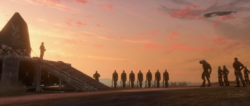
Following the final battle of the war on December 11, 2552,[59] the Human-Covenant War ended in a victory for humanity and their newfound Sangheili allies - the majority of the Covenant military having been defeated at Delta Halo by the Sangheili Fleet of Retribution, while the rest were annihilated by the joint Elite-UNSC forces at the Ark. This victory came in time to save the human homeworld, thanks chiefly to the actions of Arbiter Thel 'Vadam and Spartan John-117. The Human-Covenant War was officially declared over on March 3, 2553, when a memorial service was held near Voi, Kenya, to those fallen during the 27 years of fighting.[6]
In her inaugural speech in January 2553, President of the Unified Earth Government Ruth Charet outlined humanity's future and foreign policy, promising that they would rebuild as well as stating that humanity would now reclaim their "rightful place in the universe". While humanity was willing to coexist with other species, they would never again allow themselves to be the victims of alien aggression. While the official stance within the government and the military was to build peace with the Sangheili, the UNSC's Office of Naval Intelligence covertly worked to neutralize the Sangheili, whom they considered the most acute threat to human primacy.[60]
The end of the Covenant War did not spell a lasting peace for humankind and new conflicts soon began to emerge. Various Covenant remnants, most prominently the Jul 'Mdama's Covenant, initiated skirmishes against humanity in addition to renewed internecine conflict sparked by resurgent Insurrectionist movements such as the New Colonial Alliance. The UNSC fared significantly better against these significantly weaker incarnations of the Covenant, with improved assets and technology, such as the UNSC Infinity and the SPARTAN-IVs, at their disposal proving an advantage for the recovering UNSC.
In 2557, the Promethean forces reemerged led by a surviving Forerunner known as the Didact, who once commanded the Forerunner armies against prehistoric humanity in the Human-Forerunner War. Once awakened on Requiem, the Didact allied with Jul 'Mdama's Covenant faction, whilst defying the Forerunners' decision to pass down their Mantle to humanity by continuing his previous campaign of digital genocide. During the conflict, contact was also made with mankind's ancient benefactor, the Librarian, who had archived her personality and memories to assist humanity to guide them in their ascension to the Mantle. The Didact attempted to digitize humanity with the Composer, but was defeated at the last minute by John-117 and his AI Cortana,[7] though seven million human lives were composed.[61]
On October 2558, humanity experienced their first major setback since the end of the war. Earth and most human colonies were taken over by the Created.[62] Crippled and weakened by the Created, humanity's fleeing UNSC lost the Battle over Installation 07 against the Banished, an alien mercenary organization that had recruited humans into their ranks.[63]
Biology
Anatomy and physiology
Modern humanity is a primate, a type of mammal. They are bipedal and have five-fingered hands with opposable thumbs. Humans are warm blooded,[10] with red colored blood.
Their bone structure is calcium-based and is designed to withstand moderate stresses, but is generally weaker than the skeletons of Jiralhanae and Sangheili. Their muscular system is, on average, also weaker than most large Covenant species. If in extreme distress, humans can tap into hidden reserves of energy, known as an adrenaline rush, thus giving them drastically increased strength. This response is known as the "Fight or Flight" reflex.
In theory at least, physical conditioning can still negate the disadvantages of human physiology somewhat, and with the right enhancements and equipment, humans can overcome their physical disadvantages to an even further extent as demonstrated by the Spartans. Biological augmentation is not restricted to the Spartans; humans have routinely used bioengineering technologies for centuries, first to adapt to different conditions encountered in space and on other worlds, as well as a certain degree of enhancement given to military personnel.[64] However, such enhancements do not provide as immediately conspicuous increase in physical prowess as those of the Spartans.
Forerunner connections
- Main article: Reclaimer
Human and Forerunner genera exhibit a number of anatomical and physical similarities, despite having evolved independently on different worlds. These genetic similarities are due to the two species both originally being seeded by the Precursors from the same base stock.[65] The Forerunners themselves were intrigued by the similarities between their own race and humanity. Because of their similarities, some Forerunner scholars theorized that humans were a kindred species, created by the Precursors in their own image, just as the Forerunners believed themselves to be.[4]
The Forerunners chose humans to become the inheritors of their technology along with Forerunners' sacred Mantle, which they formerly believed to have inherited from the Precursors. The Forerunners re-encoded certain aspects of their technology (e.g. the activation index) to only respond to human DNA to stop their advanced technology getting into the hands of other races. In a mixture of guilt and hope, they passed the torch to humanity, in hope that in the future they would defeat the Flood again, which with some help, John-117 did. The Librarian imprinted the human race with a geas, a pattern of information hidden deep in the genetic code and passed on throughout generations.[4] According to the Librarian, this imprint triggered the development of many technologies which proved critical to the survival of humanity after their contact with the Covenant, as well as containing several latent abilities.[66] This may also explain the "natural" understanding of Forerunner interfaces some humans have demonstrated despite having no prior contact with Forerunner technology.[67] Latent human memories and patterns extracted during the Conservation Measure were also implanted into the genetic code of future human generations.[68][69]
Despite this, many Forerunner AI constructs seem to regard humans as Forerunner (although some fail to do so).[70] This confusion was also the root of the Covenant's campaign to exterminate humanity. In 2525, a Covenant missionary ship traveled the edge of Covenant-controlled space and discovered a planet that was covered with Forerunner "Reclamation" glyphs, who were actually the humans. Later, a report of the planet's glyphs was sent to the Vice Minister of Tranquility. He took the information to the Minister of Fortitude and he went to see the Oracle (the Forerunner AI, Mendicant Bias, in the Forerunner Dreadnought). Upon activation of the "Oracle", the AI proclaimed, "FOR EONS I HAVE WATCHED. LISTENED TO YOU MISINTERPRET. THIS IS NOT RECLAMATION. THIS IS RECLAIMER. AND THOSE IT REPRESENTS ARE MY MAKERS. I WILL REJECT MY BIAS AND WILL MAKE AMENDS. MY MAKERS ARE MY MASTERS. I WILL BRING THEM SAFELY TO THE ARK." Truth, believing that the humans were actually Forerunners (rather than their inheritors), became panicked and realized that this information could destroy the foundation of the Covenant and, with it, his power. Utilizing his power as High Prophet, Truth proceeded to launch a massive religious crusade against humanity, the Human-Covenant War. At the end of the war, when Truth was preparing to force Sergeant Major Avery Johnson to activate the Halo Array, he still believed humans to be the Forerunners' literal descendants, saying "Your forefathers wisely set aside their compassion. Steeled themselves for what needed to be done. I see now why they left you behind. You were weak. And gods must be strong."[71]
Culture and society

Humanity remains multicultural among its still marginally independent nations on both Earth and the colonies. Although humanity has adopted English as a lingua franca, other languages remain in use among human populations. Humans continue to practice a number of religions, although apart from several exceptions faith is largely considered a personal matter.
Unlike other societies, like the Sangheili, males and females serve in the military in an equal capacity; showers and housing facilities are likewise shared.[72][73] The absence of old cultural and racial hatreds within the UEG-governed humanity hearkens back to the philosophy that gave rise to it in the 22nd century, when the extremist Frieden and Koslovic ideologies threatened to consume all of humankind.[74]
Much like the cultural changes wrought by the colonization of the Earth in the past, space colonization has its own unpredictable effects on the cultures of colonial populations. While some colony worlds are multicultural from the beginning, others receive the majority of their colonists from a given region or nation on Earth, which often makes its own mark on the development of the colony's own culture. As populations settle new worlds, cultures distort and sometimes amalgamate; however, it is common for the locals to consciously hold on to their Earth cultural heritage. This often takes the form of naming the colony world's locales after the native region or local mythology of its inhabitants. Examples of such worlds include Reach, colonized by Hungarian settlers, Madrigal, with its predominantly Hispanic population, or Harvest, which fashioned its culture after the American-Scandinavian ancestry of the majority of its colonists. Over time, colonial cultures tend to retain several very conspicuous traits of their roots while others are forgotten or altered; cultures essentially become "parodies" of what they used to be.[75] Meanwhile, many of the Outer Colonies, especially those with settlers from highly varied and unregulated backgrounds,[27] appear as more chaotic hodgepodges of cultures with no single distinct origin culture in evidence. This has become all the more pronounced on independent worlds such as Venezia after the Human-Covenant War as former client species of the Covenant intermingle with the local human populations.[76]
Arts and entertainment
Urban infrastructure in many cities of the 26th century showcased a variety of architectural styles from different eras, but largely favored brutalism. 24th century colonial dwellings of the early Domus Diaspora were known to have a distinct style, described as "mostly white with blue trim"[77] and the trend of constructing buildings with similar architecture to starships began around this time, something that would come in and out of style over the years.[78]
Music has been a long tradition in human culture with historic examples such as the Rachmaninov composed Piano Concerto Number Three,[79] the Mahler composed Symphony No. 2,[80] and the Debussy composed Préludes No. 4: Les sons et les parfums tournent dans l'air du soir,[81] all of which Dr. Halsey listened to in the 26th-century. As well, there was the music of the last act of Der Ring des Nibelungen, something Richard Lash was familiar with.[82] Gabriel Thorne's grandmother was composed while practicing violin, her computer terminal displaying Mozart's Communio: Lux Aeterna from his Requiem Mass and the Ave verum corpus motet.[83]
By the 26th-century, there was the prevalent flip music an evolution of 21st-century rock.[84] The styllight was a 26th-century musical instrument.[85]
Cosmic Commedia Cooperative is a form of 25th-century absurdist theater.[86]
Military culture
The UNSC's predominance casts a distinct air of militarism over most of humanity; military service and heroism are glorified to great lengths by UNSC propaganda, as well as the media. Many residents of the Unified Earth Government seem to have a particular reverence for military history, so much that when Dr. Halsey was deciphering Forerunner coordinate data under CASTLE Base on Reach, she compared the significance of its discovery to the invention of the Translight Engine or the conical bullet.[87] For orphans who become wards of the state on UEG worlds, enlisting in the UNSC is mandatory once they come of age.[88] While the press evidently enjoys some degree of freedom,[89] the media is heavily regulated by ONI's Section Two. The UNSC adopted its policy media control after the Inner Colony Wars, when sensationalist news reports of the conflict spread mass panic and threatened to dismantle Earth's culture.[90] This aspect of humanity strengthened with the UNSC's establishment as humanity's emergency government and the unfolding of the Human-Covenant War, and shows little signs of fading following the end of the war. These practices, combined with the UNSC's policy with the colonies, have elicited accusations of totalitarianism in elements of the population, and are often pointed out by colonial secessionists in their own propaganda.
Some elements of the UNSC Marine Corps, have been a part of humanity for centuries originating back to 1775,[31] when the United States Marine Corps was founded.[31][30]
Homeworld and colonies
- Main articles: Earth, human colonies
Having possessed slipspace travel for over two centuries, humanity's sphere of influence has expanded to cover a sizable region of space surrounding their home system. These colonies are roughly divided amongst the Inner Colonies and Outer Colonies; the former consisting of the 210 worlds colonized between 2362 and 2390, and the Outer Colonies encompassing all colonies established afterward. At its height, around the 2490's, human space encompassed 800 worlds, ranging from thriving hubs of commerce and military to various lesser worlds which mostly existed to provide the core worlds with resources and foodstuffs, as well as yet smaller outposts and settlements. A significant number of these worlds were glassed by the Covenant over the course of the Human-Covenant War.[5]
While all colonies are formally represented equally within the Unified Earth Government, the true power is often perceived to rest on the Inner Colonies and Earth. This has led to widespread separatism and even civil war, and many Outer Colonies have declared themselves independent from the UEG over the decades. Because many of the colonies are invaluable to the core worlds due to the resources they produce, the UEG has historically sought to maintain its control over them by any means necessary, including military intervention, which in turn provoked the colonial insurgents all the more.[5]
Population
In October 2552, Cortana said that humanity suffered 23 billion casualties throughout the course of the Human-Covenant War, making it the minimal amount of humans alive before the war.[91]
Earth was deemed overpopulated in the 22nd century, jump-starting the colonization programs at the time.[92] Despite the colonization efforts made to resolve the overpopulation issue, Earth's population still remained in the billions.[93] The population of Earth prior to the Battle of Earth was at an approximate 10 billion: the population was said to have been cut in half at the start of the Covenant attack.[2][93] By the end of the battle, the population count was reduced to 200 million; this was both due to casualties inflicted by the Covenant as well as a massive off-planet evacuation effort.[94][95] Following the end of the Human-Covenant War, the population of Earth increased dramatically due to the influx of returning evacuees and refugees from other worlds, being again in the billions by the end of the year 2553.[94]
| Location | Planet | Population | Approximate | Circa |
|---|---|---|---|---|
| Sol system | Earth | 10,000,000,000 | Yes | Pre-Oct. 2552[93][96] |
| 200,000,000 | Yes | Nov. 2552[97][2] | ||
| 7,900,000,000 | Yes | Post-war[98] | ||
| Inner Colonies | Reach | 703,341,500 | No | 2535[43] |
| 121,000 | Yes | 2558[99] | ||
| Outer Colonies | Bliss | 500,000,000 | Yes | Feb. 2526[100] |
| Etalan | 10,000,000 | Yes | Mar. 2526[101] | |
| Arcadia | 2,998,230 | No | Pre-2531[102] | |
| Eridanus II | 510,000 | Yes | Post-war[98] | |
| Harvest | 3,000,000[Note 3] | Yes | 2525 | |
| Unknown | Ariel | 4000 | Yes | Jan. 2552[103] |
| Alluvion | 336,000,000+ | Yes | Pre-2542[104] | |
| Bounty | 199,000,000+ | Yes | Pre-Aug. 2552[104] | |
| Mesa | 219,000,000+ | Yes | Pre-Aug. 2552[104] | |
| Greydowns | 76,830,400 | Yes | Pre-Aug. 2552[104] | |
| Kroedis II | 15,000,000+ | Yes | Pre-Aug. 2552[104] | |
| Estuary | 89,000,000+ | Yes | Pre-Aug. 2552[104] | |
| Camber | 5,600,000 | Yes | Pre-Aug. 2552[104] | |
| Sigma Octanus IV | 17,000,000 | Yes | July 2552[105] |
Technology
Prior to the human-Forerunner wars, humanity had achieved a remarkably advanced technological state, having developed interstellar travel, colonized thousands of worlds outside of their solar system,[106] and even having an understanding of Precursor technology. However, nearly all records and examples of this former technology were obliterated following their war with the Forerunners. Humanity managed to develop rudimentary technology such as steam power roughly nine thousand years after their defeat.[4] Unfortunately, this technological and cultural development proved to be in vain: during a phase after the Conservation Measure's reintroduction stage, aptly termed as the dark time,[2] the species regressed back into hunter-gatherers for over 90,000 years until the development of the modern human civilizations first began.
New technologies were experimented and explored with advanced knowledge of underlying principles as talented individuals were better organized and better supplied, allowing extremely accurate and fast improvements to be made with minimized trials and costs. Such methods of thought and organization are a hallmark of humanity which differs from the Covenant who, lacking proper researching methods, would simply copy and reverse-engineer technology from ancient Forerunner artifacts via the Huragok, whilst generally having no understanding of the underlying concepts themselves. Thus it it was said that the Covenant are "imitative" while the humans are "innovative" as the war progressed.[107]
By the 26th century, human technology has not advanced equally for every concept previously explored. The most basic technologies (such as the ballistic weaponry and the wheel) have undergone few principal changes, the explanation for this being their proven reliability over centuries of use. The technology worked and so did not require heavy alteration or major changes. However, certain significant advancements have been made in other fields, such as Shaw-Fujikawa Translight Engines that allow ships to reach other star systems, as well as the creation of highly sophisticated AIs that can serve to fulfill a versatile amount of roles. In addition, humans have also developed various forms of nanotechnology which allows many advances impossible with conventional engineering. Other common construction materials include polycrete, permacrete and instacrete.
Human technology has undergone further advancements as a result of the reverse-engineering of Covenant and Forerunner technologies at the close and aftermath of the Human-Covenant War. These include, among other things, significant improvements in slipspace navigation and velocity as well as improved offensive and defensive weapons technologies, such as the more widespread adoption of energy shielding.[7][60] Thanks to technology received from the Swords of Sanghelios and Kig-Yar merchants, researchers were able to leapfrog centuries of trial-and-error experimentation and theory building.[108]
AI, robotics and automation
Human AI constructs can be grouped into two main categories; "dumb" and "smart" AIs. These labels are technically misleading, as both types are extremely intelligent, but dumb AIs are only capable of learning about subjects within their designated area of expertise, whereas smart AIs exhibit much more human-like characteristics, such as emotions, creativity and intuition. Smart AIs can only be created by scanning a human brain and replicating the neural pattern to a digital storage system known as a Riemann matrix. However, after seven years of operation, the AI will descend to a terminal condition known as rampancy. Various solutions have been attempted to counter this issue, but none are known to have been effectively implemented.[22]
Although the UNSC still relies heavily on human combatants, robotic drones are used in combat to a certain extent, often providing fire support or real-time reconnaissance on the battlefield. Examples of UNSC drones include the F-99 Wombat, the MAKO and ARGUS drones.[109]
In civilian society, automated systems—sometimes controlled by the subprocesses of a larger AI—have found uses in piloting civilian vehicles as well as performing most manual labor in agriculture and industry.[110] The scale of AI-driven automation ranges from single cities to entire worlds; the former sometimes operated by a "dumb" AI such as the Superintendent while "smart" AI Mack's oversight of Harvest's agricultural operations is an example of the latter.
Medical advances and biotechnology
Humanity has mastered a number of medical technologies, improving the quality of life in general but also providing many military applications. Among the most prominent is flash cloning, which allows the re-growth of almost any body part and is often used to replace damaged or lost organs.[27] Lost limbs may also be replaced with advanced mechanical prosthetics.[111] Humans have been effectively immunized against some conventional diseases, including cancer. Though isolated cases of cancer still occur, they can be easily treated.[48] Medical science has resolved most issues with eyesight, although some people choose to wear glasses for a variety of reasons, among them the ability to use them to project a heads-up display.[112]
On long slipspace voyages, humans use cryo chambers, allowing the occupant to enter cryonic suspension which effectively stops biological aging for the duration of the journey. These and many more advances have continued to push human longevity beyond prior estimates; with flash-cloned organ transplants, coupled with time spent in cryosleep, one's biological age may be decades less than their chronological one.[27]
The use of sterile field generators means that surgery is not only safer to perform, with a greatly reduced risk of infection, but is also able to be performed in the field. Even critical injuries can be treated with relatively limited facilities;[113] with sufficiently sophisticated equipment such as that of the UNSC Hopeful, the resuscitation of individuals traditionally considered dead is not unheard of.[114] Biological death can also be delayed by placing an individual into cryonic suspension until proper medical care can be provided.[115] A number of synthetic compounds have been developed to allow more rapid recovery from injuries or to ease the treatment of patients in general; these include biofoam, bone-knitting polymer, and polymerized hemoglobin.
Humans have also adopted a variety of bioengineering and augmentation technologies. Human enhancements saw military application in the first interplanetary conflicts.[64] While human enhancement has been commonplace for centuries, more extensive augmentation or experimentation has been limited due to ethical concerns. An exception to this are the biochemical and cybernetic augmentations used in the SPARTAN programs, which represent the peak of human medical technology in the field of biological enhancement. Human rebels also use "Rumbledrugs", which degenerate the user's body but grant them superhuman abilities for a short time.[48]
UNSC personnel are equipped with neural implants, more sophisticated models of which—typically issued to ship captains—enable a human mind to interface with computer systems and receive or send information. The neural marker is an interviewing device which can record an individual's thoughts and visualize them on a monitor.[116] Cognitive Impression Modeling allows the translation of a human brain's neural framework into digital form for the purpose of creating AIs, although this is not true mind transfer in the manner of that employed by the Forerunners: the resulting intelligence is not a perfect copy of the person it was created from due to the chaotic process in which the AI is brought into being.[22]
Space-faring
- Main article: Human starship
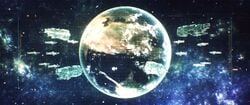
During the mid-20th century, humanity experimented with rocket technology using it to build satellites and visit and subsequently colonize the Moon and beyond in the latter half of the 21st century. With the advent of Shaw-Fujikawa Translight Engines allowing faster-than-light travel, the UNSC was able to expand well beyond the confines of the Solar System, colonizing hundreds of worlds. UNSC freighters transport food and goods between colonies, while UNSC Navy warships protect trade routes from pirates and defend colonies from enemy assault. Space elevators are used on many worlds to provide orbital transport. Advanced terraforming and climate control techniques have been developed, making human habitation possible even in many formerly hostile environments.
Human spacecraft are typically equipped with nuclear fusion engines for subluminal propulsion. These drives provide thrust via expelling either the fusion reactor exhaust or some other form of reaction propellant through a series of thruster nozzles. They are capable of remarkable thrust, allowing ships to cross interplanetary distances in a matter of hours, although gravity-assist maneuvers are commonly used to an advantage.[117][118] Rocket thrusters using triamino hydrazine as propellant are used for altitude control and small-scale maneuvering.[119] In addition to visual stealth systems, UNSC prowlers are able to use "engine baffles" to completely mask their emission profiles to match the surrounding space while running with reduced engine power.[120]
Humanity also employs a variety of gravity-manipulating technologies, including two forms of artificial gravity aboard spacecraft and space stations. The first is a system of rotating "carousel" sections which generate an approximation of gravity through centrifugal force. There is also a form of artificial gravity which does not require moving parts, but this technology consumes enormous amounts of power and spinning sections are generally regarded as being more efficient.[121] Some UNSC ships, such as Phoenix-class colony ships or UNSC frigates are equipped with a form of anti-gravity technology, as evidenced by their ability to operate in a planetary atmosphere without the use of thrusters.[122] Not all ships are equipped for atmospheric operation, however.[123] Anti-gravity is not typically implemented on craft smaller than warships and conventional engine systems are used to produce lift instead.[124]
While the weapons and combat abilities of human spacecraft were still very limited by the time of the Human-Covenant War, the reverse-engineering of Covenant and Forerunner technologies has subsequently granted humanity multiple advances in these technologies.[60]
Weapons
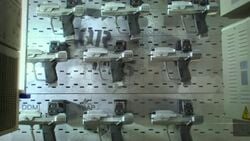
While still primarily based on projectiles and chemical reactions, human weapons are more advanced than the weapons of the 21st century. They come with a variety of electronic gadgets such as ammo readouts and are significantly more reliable, seldom malfunctioning. They are also generally immune to electromagnetic pulses. Still, there have been many advanced developments, such as electromagnetic accelerator weapons. The most prominent of these is the Magnetic Accelerator Cannon, used as the main armament on UNSC warships, and in smaller form in ground-based weapons. Another electromagnetic weapon system, known as the railgun, is used to a lesser degree. There have been developments in energy weapons such as the Spartan Laser and the pulse lasers used on UNSC prowlers. Advances in technology allow the development of highly efficient explosive devices, including the Lancet micro-missiles, capable of decimating main battle tanks.[109]
One of the largest breakthroughs came in the mid-20th century where humans discovered that nuclear fission and fusion can be used as a weapon to cause a large explosion. By the 26th century, there are several types of nuclear weapons in the UNSC's arsenal, intended for both atmospheric and exoatmospheric use. Innovation in this area would also converge in the creation of humanity's most devastating weapon during the war effort, known as the NOVA bomb.
Vehicles
Human land vehicles rely on wheeled, continuous track motion, or legs for locomotion. incorporating high-strength materials with precision engineering to improve mobility and durability, while often mounting a variety of weapons or equipment to increase their flexibility. Some use hydrogen-fuel cell engines.
Humans use marine craft on some planets.
Most human aircraft are designed with Vertical Take-off and Landing capabilities, using adjustable jet engines for lift and thrust. It is possible that some incorporate lifting body principles.
Communications
By the end of the Covenant War, humanity had developed superluminal communications systems enabling instantaneous communication and data transfer across interstellar distances.[125] Prior to this, the primary form of long-range communication was limited to manually delivering the messages to the recipient by carrying messages aboard starships.[126] For short-range communications, humanity employs conventional radio, as well as tight-beam laser[127] and maser-based systems.[119] The various human communication systems are commonly shortened to "COM".[127]
Gallery
Human skeletons in Halo 5: Guardians Forge.
Various humans in Halo Wars 2.
Human Marines around a camp fire on Installation 07 in the Halo Encyclopedia (2022 edition).
List of appearances
Notes
- ^ While Dr. Halsey mentions that the conical bullet was developed in the 18th-century, actual conical bullets saw their development circa the 1830s. The statement was likely intended to mean the 1800s, but for the sake of consistency the article will use the 18th-century designation.
- ^ An actual case named Trustees of Dartmouth College v. Woodward took place in 1819. However, the case in Halo: Saint's Testimony was mentioned as a 21st and 22nd corporate law case. While it was likely intended to be the 1819 case, it will be listed and treated similarly to it's description in Saint's Testimony
- ^ According to Halo: The Fall of Reach, Halo: Fall of Reach - Boot Camp, and Halo: The Essential Visual Guide, Harvest had a population of approximately three million. However, Halo: Contact Harvest consistently states that Harvest had a population of around 300,000, and that roughly 250,000 civilians, who constituted most of the planet's population, escaped before the planet was glassed.
Sources
- ^ a b c d e f g h Halo Waypoint: Humans
- ^ a b c d Bestiarum
- ^ a b Halo: Silentium, Rebirth Narrative
- ^ a b c d e Halo: Cryptum, Chapter ??
- ^ a b c d e f g Xbox.com, Halo Storyline: (Additional copy on HBO Forums) (Retrieved on Apr 24, 2008) [local archive] [external archive]
- ^ a b c Halo 3
- ^ a b c d Halo 4
- ^ Halo: Primordium, page 194
- ^ Halo Waypoint, Wintertime Wrap (Retrieved on Nov 18, 2022) [archive]
- ^ a b Halo Encyclopedia (2022 edition), page 16-17
- ^ a b Halo: Silentium
- ^ Halo: Silentium, pages 67-68
- ^ Halo: Primordium, page 237-238
- ^ a b Halo Legends - Origins
- ^ Halo: Primordium, p. 375
- ^ Halo: Fractures - Promises to Keep
- ^ Halo 3: The Cradle of Life
- ^ Halo Encyclopedia (2011 edition), page 296
- ^ Dr. Halsey's personal journal: June 19, 2513
- ^ a b c d e Halo: Silent Storm, chapter 4
- ^ Halo 4: Forward Unto Dawn: Part 2
- ^ a b c Dr. Halsey's personal journal
- ^ i love bees, Axon Clips, Chapter 4: Herzog: "Enigma"
- ^ a b blogspot, ilovebees, August 24
- ^ Halo: Reach, campaign level The Package
- ^ Dr. Halsey's personal journal: July 30, 2511
- ^ a b c d e Halo: Fractures - The Impossible Life and the Possible Death of Preston J. Cole
- ^ a b Xbox.com: Jake Courage (defunct, Archived)
- ^ Halo: Renegades, chapter 3
- ^ a b c Halowars.com, UNSC - Barracks (Warback Machine archive and Halopedia archive)
- ^ a b c d e Halo Encyclopedia (2009 edition), page 31: Timeline
- ^ Halo: The Flood, chapter 3
- ^ Halo: Oblivion Chapter ??
- ^ Dr. Halsey's personal journal: September 15, 2517
- ^ Halo: Tales from Slipspace - Dominion Splinter
- ^ Bungie.net: The Brute Chopper
- ^ Halo: Combat Evolved Anniversary, Terminal 1
- ^ Halo Encyclopedia (2009 edition), page 42
- ^ Halo Encyclopedia (2009 edition), page 329
- ^ Halo: Evolutions - Stomping on the Heels of a Fuss
- ^ SOTA mission page
- ^ Iris
- ^ a b Bungie.net: Halo: Reach Project Page
- ^ a b Halo: Saint's Testimony, p. 10
- ^ Halo 3, multiplayer map Orbital
- ^ Halo Encyclopedia (2009 edition), page 261
- ^ Halo 5: Guardians: Dynasty VISR description
- ^ a b c d Halo: Evolutions - Midnight in the Heart of Midlothian
- ^ Halo 4: The Essential Visual Guide, page 229
- ^ Halo: Flashpoint core rulebook, page 3
- ^ Halo Mythos, Rise of Humanity (p. 47)
- ^ Halo: Glasslands, chapter 1
- ^ Halo: Saint's Testimony, p. 7-8 (Google Play edition)
- ^ Halo Mythos, p. 47
- ^ Halo: Reach: Data pads
- ^ Halo: The Flood, chapter 1
- ^ Halo 2: Conversations from the Universe
- ^ Halo 2, campaign level Cairo Station
- ^ Halo Waypoint: Hero-Fortitude
- ^ a b c Halo: Glasslands
- ^ Halo: Escalation, issue 7: Official Summary
- ^ Halo 5: Guardians
- ^ Halo: Divine Wind, chapter 5: "'Some of the Banished humans defected to the UNSC,' Arcas said."
- ^ a b Halo Encyclopedia (2009 edition), page 44
- ^ Halo Encyclopedia (2022 edition), page 310
- ^ Halo 4, campaign level Reclaimer
- ^ Halo: The Flood, page 84
- ^ Halo: Silentium, p. 57
- ^ Halo: Primordium, p. 379
- ^ Halo Wars, campaign level Cleansing
- ^ Halo 3, campaign level The Covenant
- ^ Halo: The Fall of Reach, pages 14-15 (2001 edition)
- ^ Halo 4: Forward Unto Dawn
- ^ Halo Waypoint: The Halo Bulletin 5.14.14
- ^ Halo: Mortal Dictata, page 13
- ^ Halo: Mortal Dictata, ??
- ^ Halo: Legacy of Onyx, chapter 7
- ^ Halo: Venezian Sonata
- ^ Halo: The Fall of Reach, chapter 1
- ^ Halo: First Strike, chapter 13
- ^ Halo: Ghosts of Onyx, chapter 16
- ^ Halo: Ghosts of Onyx, chapter 22
- ^ Halo: Escalation, issue 7
- ^ Halo: First Strike, page 55
- ^ Halo: Uprising, issue 1
- ^ Halo: Contact Harvest, chapter 4
- ^ Halo: Reach, campaign level The Package
- ^ Halo: New Blood, chapter 15
- ^ Noble Team performance reports — Emile-A239
- ^ Halo Graphic Novel - Second Sunrise Over New Mombasa
- ^ Evp - Palace Hotel
- ^ Halo Encyclopedia (2009 edition), page 42
- ^ a b c Halo Encyclopedia (2009 edition), page 282
- ^ a b Twitter: @HaloWaypoint Hey, what was the population of Earth prior to November 2552?
- ^ Twitter: @HaloWaypoint Just picked up the Essential Visual Guide. Is the post war population of 200,000,000 on Earth still canon?
- ^ Twitter: @HaloWaypoint Hey, what was the population of Earth prior to November 2552?
- ^ Halo: The Essential Visual Guide, page 54
- ^ a b Halo: Warfleet, page 22
- ^ Halo: Warfleet, page 23
- ^ Dr. Halsey's personal Journal: BLISS DECIMATED!
- ^ Halo: Silent Storm, p. 74
- ^ Halo: The Essential Visual Guide, page 12
- ^ Halo: Helljumper, issue 1
- ^ a b c d e f g Halo 2: Anniversary: Terminal 3
- ^ Halo: The Fall of Reach, p. 144
- ^ Halo: Primordium, page 129
- ^ Halo: The Flood, page 132
- ^ Halo Waypoint, Armory Amore (Retrieved on Jun 1, 2020) [archive]
- ^ a b Halo: Contact Harvest, p. 16
- ^ Halo Encyclopedia (2011 edition), page 42
- ^ Halo: Contact Harvest, page 81
- ^ Halo Waypoint: The Halo Bulletin: 4.16.14
- ^ Halo: First Strike, page 140 (2003 edition)
- ^ Halo: Ghosts of Onyx, page 97
- ^ Halo: The Fall of Reach, page 329 (2001 edition)
- ^ Halo 3: ODST Pre-mission Evaluation
- ^ Halo: The Fall of Reach, pages 324-329
- ^ Halo: The Fall of Reach, page 17
- ^ a b Halo: Contact Harvest, page 25
- ^ Halo: Ghosts of Onyx, page 43
- ^ Halo Encyclopedia (2009 edition), page 211
- ^ Halo 3, campaign level The Storm
- ^ Halo: The Flood, page 40
- ^ Halo: Ghosts of Onyx, page 135
- ^ Data Drop
- ^ Halo: Contact Harvest, page 35
- ^ a b Halo: Ghosts of Onyx, page 50
| |||||||||||||||||||||||||



